Translate this page into:
Distal Driving of Molar by Smart Distal-propeller Appliance
Address for correspondence: Dr. U. H. Vijayashree, Department of Orthodontics and Dentofacial Orthopedics, KLE Institute of Dental Sciences, Bengaluru - 560 022, Karnataka, India. E-mail: vijayashreeortho@gmail.com
This article was originally published by Wolters Kluwer and was migrated to Scientific Scholar after the change of Publisher.
Abstract
In recent years, maxillary molar distalization with noncompliance mechanics has been an increasingly popular method for the resolution of Class II malocclusion. This communication describes one particular molar distalizing appliance, the Smart distal-propeller appliance which is simple, inexpensive, easily fabricated that can be used for unilateral or bilateral molar distalization.
Keywords
Bodily movement
distal propeller
molar distalization

[SHOW_RELATED_PUBMED_ARTICLES]
Introduction
Maxillary molar distalization using headgear requires patient’s cooperation, and hence, the results may be unpredictable.[1] Thus, to overcome this, numerous noncompliance intraoral appliances such as pendulum,[2] repelling magnets,[3] distal jet,[4] Jones and White jig,[5] nickel-titanium (NiTi) springs, superelastic wires,[6] first class appliance,[7] and simplified molar distalizer[8] are being routinely used for maxillary molar distalization. As these appliances are tooth borne, they can cause anterior proclination. To eliminate the undesirable side effects on the anterior arch, miniscrew-supported molar distalization appliances such as skeletal frog appliance[9,10] are being used. Major limitation of commercially available newer appliances includes cost factor. Although few of the commonly used noncompliance appliances are economical, they mainly result in distal crown tipping of molars and palatal mucosal irritation.[11]
The present article introduces a smart distalization appliance, which is simple, inexpensive, easily fabricated that brings about almost bodily tooth movement of maxillary first molars. The smart distal-propeller appliance [Figure 1] works on the same principle as distal jet appliance, i.e., allows almost translatory distal molar movement and can be used for unilateral or bilateral molar distalization.

- Smart distal-propeller appliance (a) unilateral distalization (b) bilateral distalization
Fabrication and Placement
After initial leveling and alignment of the maxillary arch, impressions were made with polyvinyl siloxane impression material for optimal accuracy; washed and disinfected with 2% glutaraldehyde and poured with dental stone for fabrication of a working model.
On the working model, the smart distal-propeller appliance was fabricated with the following components:
Distalizing unit
A hollow metallic tube [Figure 2A(1)], which was a cut section of 18-gauge needle, ** was embedded in the Nance button
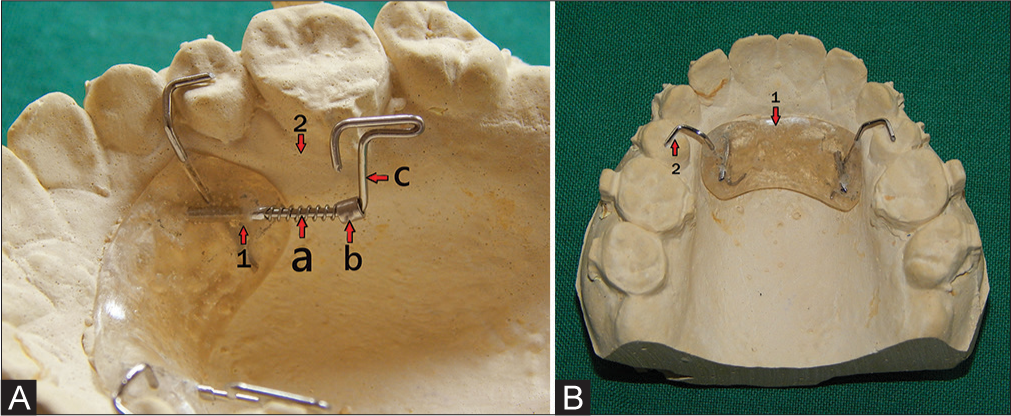 Figure 2
Figure 2- (A) Distalizing unit, (1) Hollow metallic tube, (2) Sliding component: (a) Horizontal arm. (b) Stopper. (c) Vertical arm. (B) Anchorage unit: (1) Modified Nance button. (2) Anchor arm
-
A sliding component [Figure 2A(2)] made up of 0.032” round TMA wire to be inserted in the lingual sheath on the molar bands. This sliding component consists of the following:
A horizontal arm which is inserted in the hollow metallic tube of Nance button with open-coil NiTi spring
A stopper or helix of 2 mm at the junction of horizontal and vertical arm to act as a stop for open-coil NiTi spring
A vertical arm with a tab to incorporate in the lingual sheath.
Anchorage unit
Modified Nance button [Figure 2B(1)] fabricated with cold cure acrylic covering a larger area of the palate
Anchor arms [Figure 2B(2)] on occlusal surface of maxillary first premolars fabricated with 0.036” stainless steel wire for anchorage.
The anchorage unit consisting of modified Nance button and anchor arms is placed intraorally by bonding of anchor arms on the occlusal surface of maxillary first premolars using composite resin. The distalizing unit consisting of sliding component with compressed NiTi open-coil spring (0.010” × 0.030”) of resting length 10 mm (generating 200 g of force) was placed on the horizontal arm. The above assembly is slided onto the hollow metallic tube embedded in Nance button. The vertical arm with a tab was incorporated in the lingual sheath and was secured [Figure 3]. Molar distalization by pure translation without any buccolingual rotation could be achieved only if the force was applied both in palatal and buccal aspects.[12] Hence, a NiTi open-coil spring compressed with resting length of 5 mm (generating 100 g of force) was placed on the buccal aspect between second premolar and first molar stabilized on 0.019” × 0.025” stainless steel wire to counteract rotational moment in sagittal as well as in transverse plane [Figure 3]. At the end of 9 weeks, 5 mm of distalization was achieved in the maxillary right quadrant [Figure 4] with minimal palatal irritation [Figure 5a]. End-on molar relation [Figure 5b] was corrected to Class I molar relation [Figure 5c] with the minimal of anterior anchor loss.
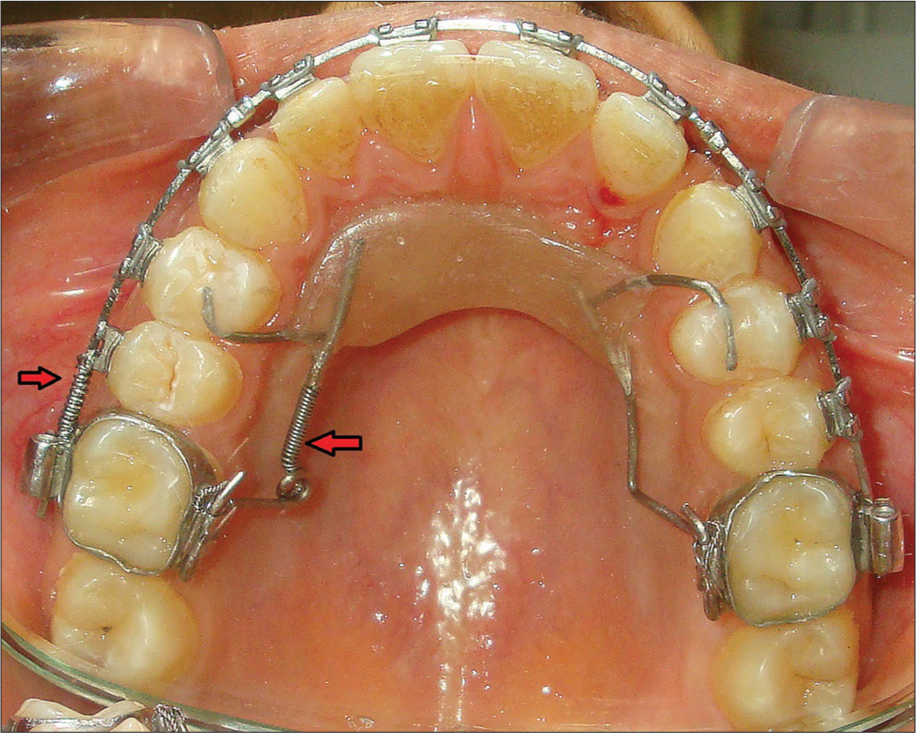
- Intraoral smart distal-propeller appliance, with nickel-titanium coil spring in palatal and buccal region for unilateral maxillary first molar distalization
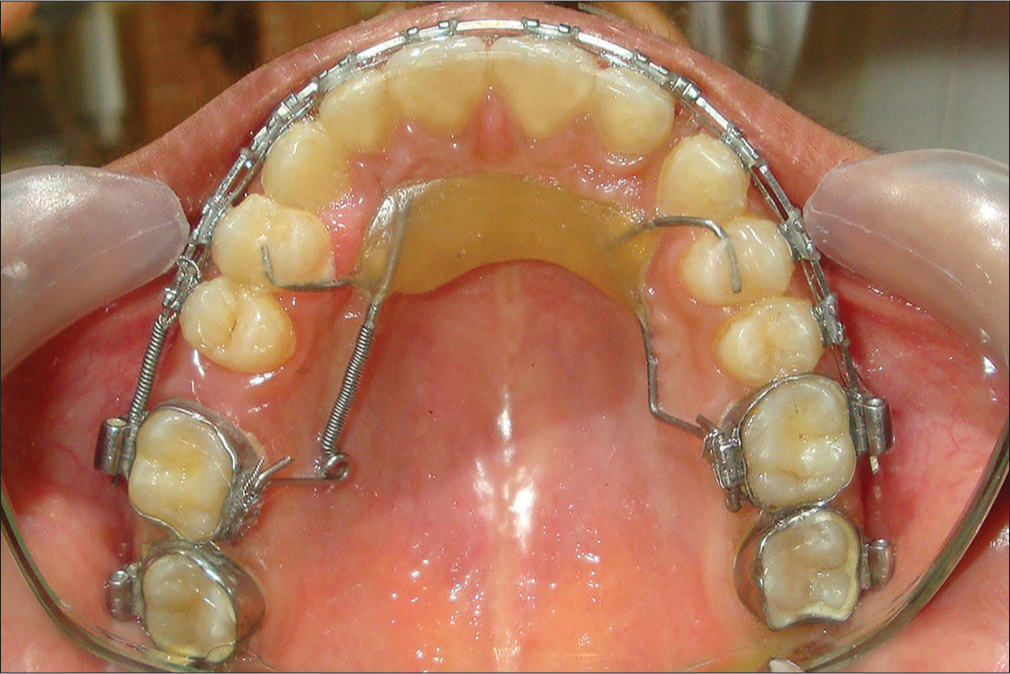
- Five millimeter of molar distalization achieved in 9 weeks
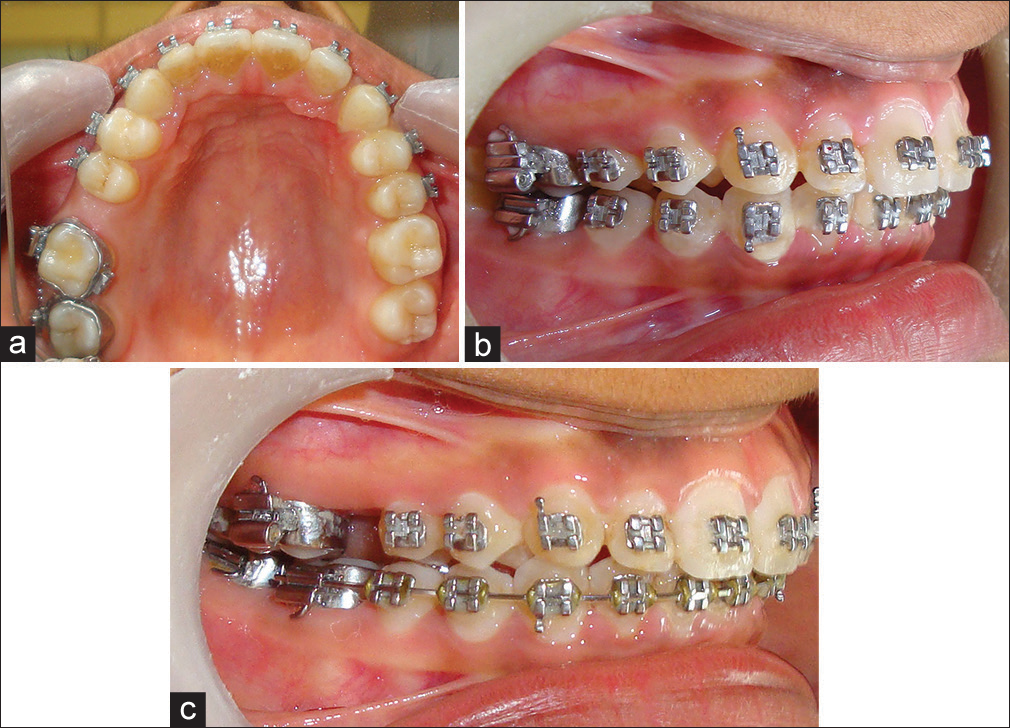
- (a) Postdistalization shows minimal palatal tissue irritation after appliance removal. (b) Predistalization endon molar relation seen on the right lateral photograph. (c) Postdistalization Class I molar relation seen on the right lateral photograph
Discussion
One of the factors according to Gianelly (1988) that influences the rate of distal molar movement is the type of movement.[3,13] Slow movement occurs when the molar is moved bodily in distal direction. The anchorage is obtained from the modified Nance button which explains this minimal anchorage loss. This smart distal-propeller appliance can also be used for bilateral molar distalization [Figure 6] and can be used along with palatal miniscrews to further enhance anchorage to eliminate the undesirable side effects on the anterior arch.
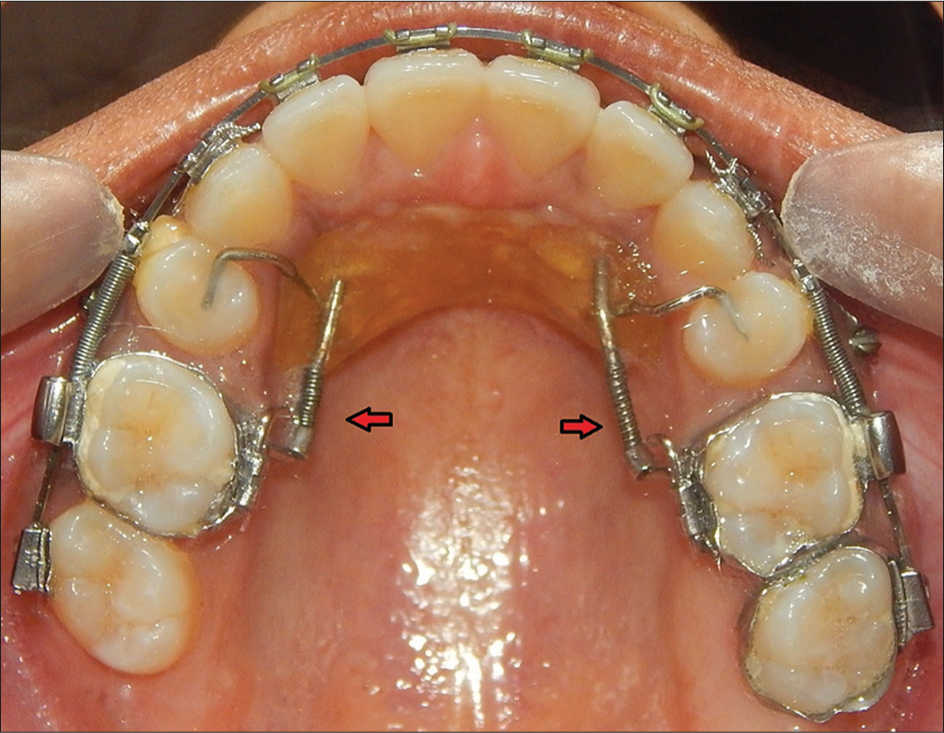
- Smart distal-propeller appliance for bilateral molar distalization
The smart distal-propeller appliance offers the advantages of simplicity of design, being economical, easy of fabrication and can be used unilaterally/bilaterally with minimal palatal irritation. Significant feature of this appliance is that almost translatory movement of the distalizing molars is possible.
Financial support and sponsorship
Nil.
Conflicts of interest
There are no conflicts of interest.
**18X11/2 ”, 1.20X 38mm, Johnson & Johnson Ltd.
References
- Molar distalization with a pendulum appliance K-loop combination. Eur J Orthod. 2010;32:459-65.
- [Google Scholar]
- The pendulum appliance for class II non-compliance therapy. J Clin Orthod. 1992;26:706-14.
- [Google Scholar]
- Rapid class II molar correction with an open-coil jig. J Clin Orthod. 1992;26:661-4.
- [CrossRef] [Google Scholar]
- The first class appliance for rapid molar distalization. J Clin Orthod. 1999;33:322-8.
- [Google Scholar]
- The skeletal frog appliance for maxillary molar distalization. J Clin Orthod. 2011;45:77-84.
- [CrossRef] [Google Scholar]
- Upper molar distalization on palatal miniscrews: An easy to manage palatal appliance. Prog Orthod. 2012;13:78-83.
- [Google Scholar]
- Distalization of maxillary molars with the bone-supported pendulum: A clinical study. Am J Orthod Dentofacial Orthop. 2007;131:545-9.
- [Google Scholar]
- Unilateral spring space regainer: A smart way to drive molar distally. APOS Trends Orthod. 2013;3:163-6.
- [Google Scholar]
- Maxillary unilateral molar distalization with sliding mechanics: A preliminary investigation. Eur J Orthod. 2001;23:507-15.
- [Google Scholar]





